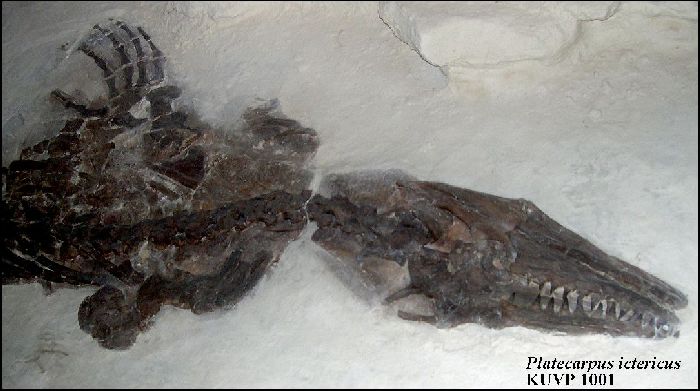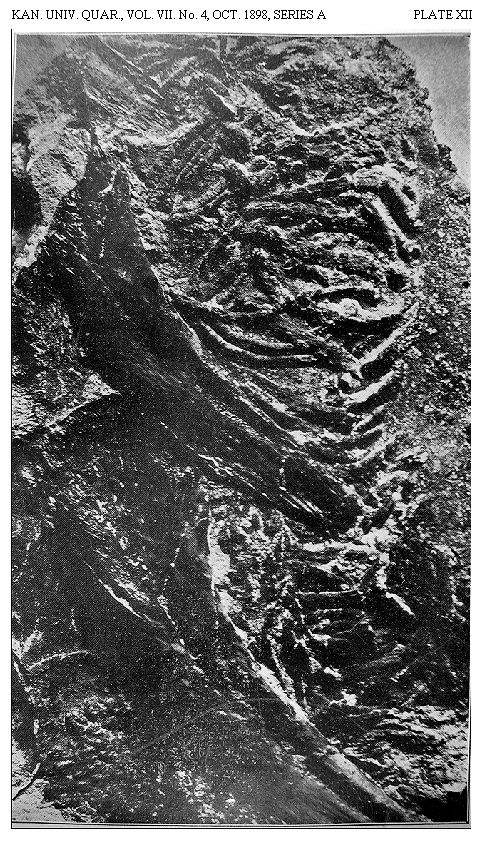
Some Additional Characters of the Mosasaurs
Contribution to the Paleontological Laboratory, No. 42.
By S.W. Williston
(1899)
With Plate XII
Copyright © 2008-2014 by
Last updated 07/19/2014
 |
Some Additional Characters of the Mosasaurs Contribution to the Paleontological Laboratory, No. 42.
By S.W. Williston (1899) With Plate XII
Copyright © 2008-2014 by Last updated 07/19/2014 |
Wherein S.W. Williston mistakenly identifies the calcified tracheal rings of a Platecarpusspecimen as a nuchal (dorsal fringe). However, this specimen (KUVP 1001) which has been largely ignored, contains a wealth of other information: the impression of the soft tissue of the front paddle, a pathology of the shoulder, scale impressions and stomach contents (fish, cf. Cimolichys).
KUVP 1001 was "discovered by Mr. A. Stewart a mile and a half from Elkader on the Smoky Hill River, and includes the complete animal to the base of the tail. The skin was preserved entire, but, when exposed to the air, very much of it has flaked off. By the use of shellac, however, considerable patches have been preserved." (Willliston 1898, p. 235)
|
Some Additional Characters of the Mosasaurs Contribution to the Paleontological Laboratory, No. 42. --------------------- BY S. W. WILLISTON ---------------------- With Plate XII In the last number of this Quarterly there was a brief note concerning some interesting new features of Platecarpus, as derived from a remarkably perfect specimen collected the past summer in Gove County, Kansas. With the present communication is given a photographic illustration of the nuchal fringe, there briefly described. The fringe in the specimen fortunately lies slightly displaced from the vertebral column in the neck, so that it is visible as far back as the scapula of the right side, beneath which it disappears. The length of each individual “thong” cannot be made out, since they are more or less entangled, but they seem to be four or five inches long. They are numerous, starting in a close row and lying loosely on each side. I am not able to compare them with the dorsal projections of any of the recent lizards in which similar structures occur, but certainly the striking fact that such appendages do occur in this genus of the Mosasaurs, at least, adds another argument to prove the close relationship of the Mosasaurs with the lizards. The thongs were evidently nearly round in cross-section, and loose and pendulous, not standing up rigidly. The foremost ones are found in the specimen lying beneath the angle of the mandible, so that it is evident the fringe began at the posterior part of the head. How far backward it reaches can not be said without removing the bones beneath which they disappear. In all probability, it continues well back along the dorsal region, possibly on the tail. The last cervical ribs are shown in part of the illustration. The first thoracic rib, attached to the eighth post-cranial vertebra, has a length of over 300 millimeters; its distal end is covered so that its precise length can not be made out. The last cervical rib has a
(39) Kansas University Quarterly, Vol. VIII, No. 1, Jan. 1899, Series A. |
40
KANSAS UNIVERSITY QUARTERLY
length of 140 millimeters. There are twelve vertebræ that may be called thoracic. The ribs in this region measure respectively: first rib, about 350 mm.; second, 440 mm.; third, 440 mm.; eleventh, 410 mm.; twelfth, 160 mm. There are ten dorso-lumbar ribs to the beginning of the pygal region, the whole number of the precaudal vertebræ being twenty-nine. I am very much inclined to believe that the different individuals of any species may vary somewhat in the number of dorso-lumbar and post-dorsal vertebræ. The posterior thoracic ribs are more slender and less stout than the anterior ones. The coastal cartilages, which are so frequently found in all the genera, are flattened and pitted, of a less dense and more granular structure than the true bones. They lie in this specimen parallel with each other in several rows. In the present specimen there is a well ossified sternum, broadly crescentic in shape, with the posterior border concave, and the deep grooves for the reception of the coracoids placed widely apart and at an obtuse angle with each other. From the fact that one of the coracoids shows much exostosial growth, united thereby with the scapula, I am inclined to believe that the ossification of the sternum may be due to pathological causes, and that, normally, the sternum of this genus, as in others, is composed of calcified cartilage, as are the costal ribs. On the other side of the sternum and partially ossified with it, projecting in front as a broadly spatulate, thin process, is the interclavicle. The posterior portion is slender and not very long; at its anterior, truncate extremity, there are two oval facets, as though for the articulation of bones. The front paddle resembles in its position very much that of P. ictericus given by me in plate xliv, vol. iv, Univ. Geol. Surv. Kans., except that every bone is in its normal position. The edge of the fleshy portion, which is clearly outlined, follows the sweep of the radial side of the fingers about an inch distant. Between the fourth and fifth finger the edge of the membrane is concave to the tip of the fifth finger. Thence the margin extends broadly inward to the side of the body. The paddle evidently was not pedunculated, but was broadly connected with the body. The outline of the body in the abdominal region was clearly traced in collecting the specimen; it is about as represented in the restoration of Clidastes. Not the least interesting information furnished by this specimen is that concerning the food of the animal. Quantities of its remains were discovered in the abdominal region, matted together and |
| WILLISTON: ADDITIONAL CHARACTERS OF THE
MOSASAURS.
41
more or less comminuted. A close examination of these remains discloses nothing but fish bones, and usually only those of small size. The largest observed is a vertebra of Empo, or some allied fish, of about four feet in length. The remains furnish conclusive evidence that the food of these animals consisted chiefly if not entirely of fishes, and, moreover, fishes of small or moderate size. The skin preserved in this specimen does not differ materially from the same membrane in Tylosaurus; the scales appear to the somewhat larger and the carina is indistinct, though this may be due to the condition of preservation. The hyoid bones in this genus resemble those of Tylosaurus (Univ. Geol. Surv. Kans., iv pl. xxi, there wrongly referred to Platecarpus). The presphenoid is well preserved in the skull; it is quite like the same element in Varanus.
PLATE XII Nuchal fringe and cervical ribs of Platecarpus coryphaeus, natural size.
|
 |
Suggested references:
Everhart, M.J. 2005. Oceans of Kansas - A Natural History of the Western Interior Sea. Indiana University Press, 322 pp.
Osborn, H.F. 1899. A complete mosasaur skeleton, osseous and cartilaginous. Memoirs of the American Museum of Natural History 1(4):167-188.
Williston, S.W. 1898. Editorial Notes. Kansas University Quarterly 7(4):235.
Williston, S.W. 1899. Some Additional Characters of the Mosasaurs. Kansas University Quarterly 8(1):39-41, 1 pl.
Williston, S.W. 1902. Notes on some new or little-known extinct reptiles. Kansas University Science Bulletin 1(9):247-254, 2 pl.